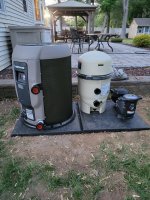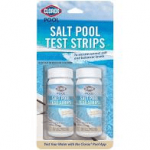Ha !!!! So was mine. It went to the garage with a hand truck and some 4 letter words but it was only once there and once back per year.My heater is two times the size of my air conditioning condensing unit. There's no way that's coming inside for the winter.
Pool equipment installer says heaters never need bypass valve
- Thread starter xpert66
- Start date
You are using an out of date browser. It may not display this or other websites correctly.
You should upgrade or use an alternative browser.
You should upgrade or use an alternative browser.
When the heater was delivered it had a tip indicator and I was to refuse it if it was tipped past a certain degree. I was told not to use a hand truck to transport it to where my pool equipment was going so I had to put it on the dolly and roll it over to avoid tilting it. Just did that today with my neighbors helpHa !!!! So was mine. It went to the garage with a hand truck and some 4 letter words but it was only once there and once back per year.
Last edited:
- Jan 4, 2016
- 5,290
- Pool Size
- 44000
- Surface
- Plaster
- Chlorine
- Salt Water Generator
Just take a pic of transporting on the dolly for any silly future warranty aspects, then move it the easiest way ;-)
Really glad to know that advice here was helpful.
TFP is great value. We can save you heaps of money and time worth way more than the one-time tax deductible donation to become a supporter. Become a TFP Supporter. But also, if times are tight with all the pool spending, totally understand, and you will get great advice either way.
Really glad to know that advice here was helpful.
TFP is great value. We can save you heaps of money and time worth way more than the one-time tax deductible donation to become a supporter. Become a TFP Supporter. But also, if times are tight with all the pool spending, totally understand, and you will get great advice either way.
seems like a dig at meJust take a pic of transporting on the dolly for any silly future warranty aspects, then move it the easiest way ;-)
- Jan 4, 2016
- 5,290
- Pool Size
- 44000
- Surface
- Plaster
- Chlorine
- Salt Water Generator
Not meant to be, I generally say what I mean. Sorry for throwing you off.seems like a dig at me
It's my same sentiment of being distrustful of vendors and manufacturers, who seem to more and more these days trying to squirm out of warranty coverage by demonstrating something not in line with their manual. So as consumers, we just have to be mindful of being in a strong position if a claim is ever needed.
I've hung heaters from ceilings and they sure as heck get tilted as you wrestle them up onto lifts or scaffold and into place! So it seemed a bit funny to me. If it's a heat pump, I can comprehend the issue, but that would be more about letting it sit overnight, level, before starting, and not letting it go upside down or even close to 90 degrees from horizontal, but I wouldn't hesitate to put it on a hand truck.
No offense intended, by any means.
Just kidding with ya. So it was a waste of time taking 2 hours to make sure I do not tilt the heater moving it yesterday?Not meant to be, I generally say what I mean. Sorry for throwing you off.
It's my same sentiment of being distrustful of vendors and manufacturers, who seem to more and more these days trying to squirm out of warranty coverage by demonstrating something not in line with their manual. So as consumers, we just have to be mindful of being in a strong position if a claim is ever needed.
I've hung heaters from ceilings and they sure as heck get tilted as you wrestle them up onto lifts or scaffold and into place! So it seemed a bit funny to me. If it's a heat pump, I can comprehend the issue, but that would be more about letting it sit overnight, level, before starting, and not letting it go upside down or even close to 90 degrees from horizontal, but I wouldn't hesitate to put it on a hand truck.
No offense intended, by any means.
phonedave
Well-known member
- May 30, 2012
- 1,972
- Pool Size
- 17000
- Surface
- Vinyl
- Chlorine
- Salt Water Generator
- SWG Type
- Hayward Turbo Cell (T-CELL-5)
Other than a small amount of increased complexity (and another place that could potentially leak ) I just don't see the downside of having one.
That is the answer right there.
Is there a downside to having one - aside from complexity or cost.
In my opinion, a good contractor would tell you - I really don't think you need one, but adding one is not going to hurt anything, but it will cost you an extra $150 (or whatever it is)
I do most of my own work around here, but I have used contractors for some bigger jobs that I just don't have time to do. I have always talked with them about what they are going to do, mentioned specific things I would like, and then listened to their feedback. Most of the time my conversations are around the routing of things like exhaust and electrical conduit. It has always been a discussion and we arrive at a solution. I think that is what makes both a good contractor and an easy to work with customer.
In this case, I would want a bypass as well. It is easy enough to rig in a pipe if you have to, but that requires moving the heater and digging around in the empire of dirt to find a spare pipe and fittings of the correct size. I would much rather be able to turn two valves and be done with it.
As I previously mentioned, if you are careless enough to leave a heater powered on with a fuel supply also on, AND the temperature set higher than the ambient air (or water ) inside the pipe, AND if the flow switch should fail closed ( very unlikely ) AND you have the bypass closed, there is a risk that it could dry-fire and burn up your heat exchanger, or cause a steam pressure explosion ( or even the dreaded BLEVE ) in the isolated part of the piping loop ( in this extreme worst-case scenario, the temperature sender or the controller would also have had to experience a simultaneous low-read failure mode, or the gas valve would have to simultaneously fail open (EXTREMELY unlikely) ). All of this COULD happen. Quantum mechanics also states that there is a VERY small but non-zero chance that monkeys might fly out of my butt. 
Last edited:
Those are two biggies. Particularly the cost. Quality 3 way valves were pushing $200 recently and the check valve is probably $100 itself. Add a 50% markup for the builder and $100 for labor (only because it’s quick and easy for him), And yeah, It’s probably a $500 job.Is there a downside to having one - aside from complexity or cost.
My entire points above were that it may not be the best $500 OP could have spent at this point.
Our job here is to unbiasedly give the OP all the info to make their best decision. I never need to be ‘right’, just need to get the info out there to be considered. Factoring in all the info OP made their choice and it’s best for him, which is a good, educated decision.
Which is awesome. Long live TFP !!!
Yes that's what I thought. I guess it's true, if you want something done right do it yourself. Been doing a lot of research on it I think that's my best resourceThat is the answer right there.
Is there a downside to having one - aside from complexity or cost.
In my opinion, a good contractor would tell you - I really don't think you need one, but adding one is not going to hurt anything, but it will cost you an extra $150 (or whatever it is)
I do most of my own work around here, but I have used contractors for some bigger jobs that I just don't have time to do. I have always talked with them about what they are going to do, mentioned specific things I would like, and then listened to their feedback. Most of the time my conversations are around the routing of things like exhaust and electrical conduit. It has always been a discussion and we arrive at a solution. I think that is what makes both a good contractor and an easy to work with customer.
In this case, I would want a bypass as well. It is easy enough to rig in a pipe if you have to, but that requires moving the heater and digging around in the empire of dirt to find a spare pipe and fittings of the correct size. I would much rather be able to turn two valves and be done with it.
I am girding my loins for a DIY SWG installation later this spring. I might be hitting you guys up for advice.
mguzzy
Gold Supporter
We are ready when you are to install your SWG... SO what is it exactly in a heater that you can't tip them? Mine doesn't have any sloshing liquid in or anything.
I hate it when that happens.. cause then they are off writing Shakespeare. (obscure reference alert, to those that get it)Quantum mechanics also states that there is a VERY small but non-zero chance that monkeys might fly out of my butt.
SO what is it exactly in a heater that you can't tip them? Mine doesn't have any sloshing liquid in or anything.
They are European heaters, you don't have to tip them...
Joking aside, I believe that the heat-pump type has refrigerant and delicate internal tubing. So it's the same reason you wouldn't want to tip a refrigerator, because that's basically what it is, except in reverse. My old Ray-Pak could probably fall off the back of a truck while in motion and it would still work.
mguzzy
Gold Supporter
Ah .. ok that makes sense.. mine is just and old school, brute force, gas heater. I think I tipped it on its side and rolled it onto the slab when I installed it.Joking aside, I believe that the heat-pump type has refrigerant and delicate internal tubing. My old Ray-Pak could probably fall off the back of a truck while in motion and it would still work.
[European Heaters... good one]
Thread Status
Hello , This thread has been inactive for over 60 days. New postings here are unlikely to be seen or responded to by other members. For better visibility, consider Starting A New Thread.






